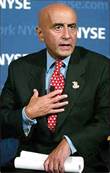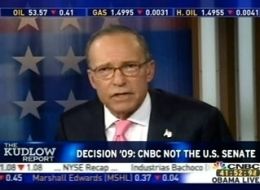Yesterday’s announcement that comedian Jon Stewart, 52, is leaving the Daily Show after 17 years as host and writer, marks a major turning point in comedy, but also in how news is presented.
TV critics have rightfully pointed out that the show’s irreverent style, humor and tweaking the face of established political forces in Washington hit the mark with an entirely new demographic that was never touched by mainstream news broadcasts. The show hit a tenor, albeit liberal, which also attracted an audience from all citizens who are disaffected with politics-as-usual in Washington.
This message should be heeded by financial journalists. The reason is that financial journalism needs its own version of the Daily Show to counterbalance the blatantly pro-industry, pro-corporatist, anti-investor bias evident in print and broadcast financial journalism today.
These biases are so ingrained that most professional financial journalists don’t even recognize the slant in their coverage unless there is a major institutional failure or federal investigation. Even then, the record fines and huge scale of frauds in LIBOR, credit ratings, currency trading, CMOs, and mortgages are treated as slow-motion car wrecks that take years to analyze, investigate and litigate without informed reporters recalibrating their assumptions about the industry they cover.
In fact, I would bet that most financial reporters consider the unprecedented frauds which have been revealed since the 2008 recession as just the bad deeds of a few errant individuals and not indicative of anything systemic. It would be bad taste to even suggest that many segments of the financial services industry (including fund companies and industry trade associations) are designed to take advantage of their own customers, or that the $164 million in fees paid daily by 401(k) participants are actually delivering above-index returns.
Too many reporters also consider it bad taste or are just not even aware that revenue sharing and 12b-1 fees cost investors about $9.5 billion annually from their own 401(k) accounts. Without discussing these facts, all those who write about retirement habitually suggest that nest-egg shortfalls are all due to people not saving enough or else not investing in the mutual fund-of-the-month. Instead, this type of colonial advice lays the blame about not having enough to retire on investor-customers and not the financial professionals who are handsomely paid to manage and administer the nation’s private 401(k) system.
Identifying the Biases
Given this dominant perspective, it’s no wonder that serious reporting about the behind-the-scenes brutal lobbying to kill the decidedly pro-investor fiduciary standard, investigations into the excessive fees charged in the mutual fund industry or why ETFs are not the new standard investment product in 401(k) plans are not broadly reported and never given the same visibility as the data-numbing reports on earnings, endless guessing about when QE will end, or the incessant talk by mesmerized reporters about the unquestioned universal benefits of technology, venture capitalists and hedge funds. All of these, in case most editors have not noticed, are not remotely interesting or relevant to the average investor.
It’s no wonder that the mass investing public has lost faith in their ability to prepare for retirement and why the endless stream of new surveys and studies show that Americans are ill-prepared and afraid to retire. The lame advice most commonly offered is for people to save more and reduce consumption, even though real incomes have not increased since the Reagan presidency.
Even reporters who specialize in personal finance are often ill-equipped, not aware or afraid to ask executives in the mutual fund industry, the most common area which affects millions of average investors, about the ill-effects of 12b-1 fees, revenue sharing and the lock between companies that provide 401(k) administrative services featuring their own in-house funds and whether the net effect of these three anti-investor practices actually deliver better net returns than alternative combinations of 401(k) structures.
The reason these questions are never asked is that the editors who drive coverage and the reporters who are on the front lines asking the questions often lack industry knowledge about what’s behind the curtain in the financial services industry. The blatant conflicts-of-interest that are at the root of the heated debate about financial advisors adopting the fiduciary standard are not well known by editors, or worse, they are off their radar screens because more aggressive reporting about these conflicts would not buttress the corporatist positions knowingly and unknowing practiced by most financial journalists. After all, Wall Street reporters who ask tough questions might not get invited to the Financial Follies or other selective events, or else they could be labeled as too aggressive.
I learned this first-hand when I broke the story about former NYSE Chairman John Phelan’s secret $10 million bonus awarded when he retired in 1990. At the time, I wrote the story for a small futures publication in London (Futures and Options World), but when I tried to offer it to the Wall Street Journal, no one would touch it. I then met the editor of a small U.S. trade magazine, Investment Dealer’s Digest, at a party and he published it. The story then appeared in the front section of the Journal about a week later. Even though the Wall Street Journal had its editorial office a few blocks from the NYSE, this incident showed the myopic coverage of the cornerstone of American capitalism.

At the time, no one discussed salaries and bonuses, even a historic, secret one like Phelan’s. This fact was not lost on Phelan’s second in command, Richard Grasso, who stayed at the NYSE another few decades and then engineered one of the biggest public heists on Wall Street when he left the exchange with a bonus package of $187 million that sparked years of litigation.

Flash forward, 30 years and you still would never hear pro-investor initiatives discussed on FOX business or CNBC by the likes of corporatists, such as Stuart Varney, Joe Kernan, Larry Kudlow, Neil Cavuto or other on-air commentators who would rather rail against taxes, big government, global warming, unions, regulation or other libertarian targets.
Time for a New Perspective
But as the Daily Show points out, a new perspective can gain a huge, publicly-acclaimed popular following. Financial journalists should sense that their less evident, but definite anti-investor bias is sensed by millions of Americans who know that their financial goals are being derailed by something, someone, somewhere on Wall Street.
Maybe it’s even time to start a new publication, such as “The Progressive Investor,” which would inject discussion about the political economy of Wall Street and what drives its business and actual suggestions about how average investors can get the most for their own retirement by sticking to some simple steps and finding the right low-cost products and objective, independent advisors.
This would be welcome since naïve American investors know when they are getting the short-end of the deal. They know it today when they keep hearing that the way to retire is by saving more and reducing their standard of living, while the top 1% gets incessantly wealthier. These naïve investors also know that the Washington code words for the lowering living standards of the American middle-class is not any form of class warfare between rich and poor, but a legitimate debate about giving consumers what they are paying for and changing the tax system.
As noted in my book, How 401(k) Fees Destroy Wealth and What Investors Can Do to Protect Themselves, the Progressive pro-consumer movement which saw the creation of federal agencies dating back to the early-1900s followed by product innovations that re-shaped the retail industry since the 1960s have never happened in the financial services industry. More Americans are recognizing this fact and link it to the current reality that they are taking all the risks for shaping their financial futures, paying high fees and suffering variable investment returns, with no safety net except a reverse mortgage in the event another major recession erases their wealth.
“The financial services industry spent $3.4 billion on lobbying from 1998 to 2008 alone…this was more than was spent by the combined contributions from the energy, health care, defense, and telecommunications industries.”
More investors also sense that the financial services industry works against their interests. They may not know the details, but they would be shocked to discover how their own investments generate fees that become mutual fund company revenues that are then turned into lobbying budgets given to pro-industry groups that then devise regulations and laws that are distinctly anti-customer.
This explains how the financial services industry spent $3.4 billion on lobbying from 1998 to 2008 alone. During this period, lobbying money from the financial services industry alone was more than was spent by the combined contributions from the energy, health care, defense, and telecommunications industries. And what did all this lobbying money buy? Anti-customer rules, regulations and legislation. This byzantine accounting is the modern equivalent of victims digging their own graves, but it’s not done with shovels, but checks written to the most powerful anti-customer lobbying firms in Washington.
Even worse, there is nothing on the horizon to rectify this situation. The Republicans are conducting a distinctive war against retirees by attempting (and this is only a partial list) to reduce or privatize Social Security, eliminate Dodd-Frank, the Volker Rule and de-regulate anything which touches financial institutions at the federal and state levels. The Republicans have even gone so far as to force the U.S. Postal Service (USPS) to fully fund its future pensions and health care costs (through the Postal Accountability and Enhancement Act of 2006), even for people who have not even been hired. This requirement applies to the USPS, even though no private U.S. corporation has even been forced to do it.
So how would the Daily Show handle these thorny financial topics?
My bet is that they would parody them to make them more palatable and understandable to a wider audience. Then, the meaning of these more esoteric maneuvers would become very evident. For instance, what would an average viewer think it he discovered that mutual fund wholesalers are among the highest paid profession in the U.S., especially when no one ever heard of a mutual fund wholesale, including many financial reporters? That would illuminate a very gray part of the financial services industry.
Where the comedy comes in should be left to the experts. But the Daily Show’s genius is that it offered a new perspective. This is long overdue for financial services reporters who need to adopt a new perspective on their daily beats and admit that they can be either pro-investor or anti-investor in their tone of reporting and practices. But they definitely cannot be both. Reporters should also question their journalistic corporate culture to see if they are being guided by a corporatist mantra or if they are really independent, critical thinkers. The answer may surprise a few.










